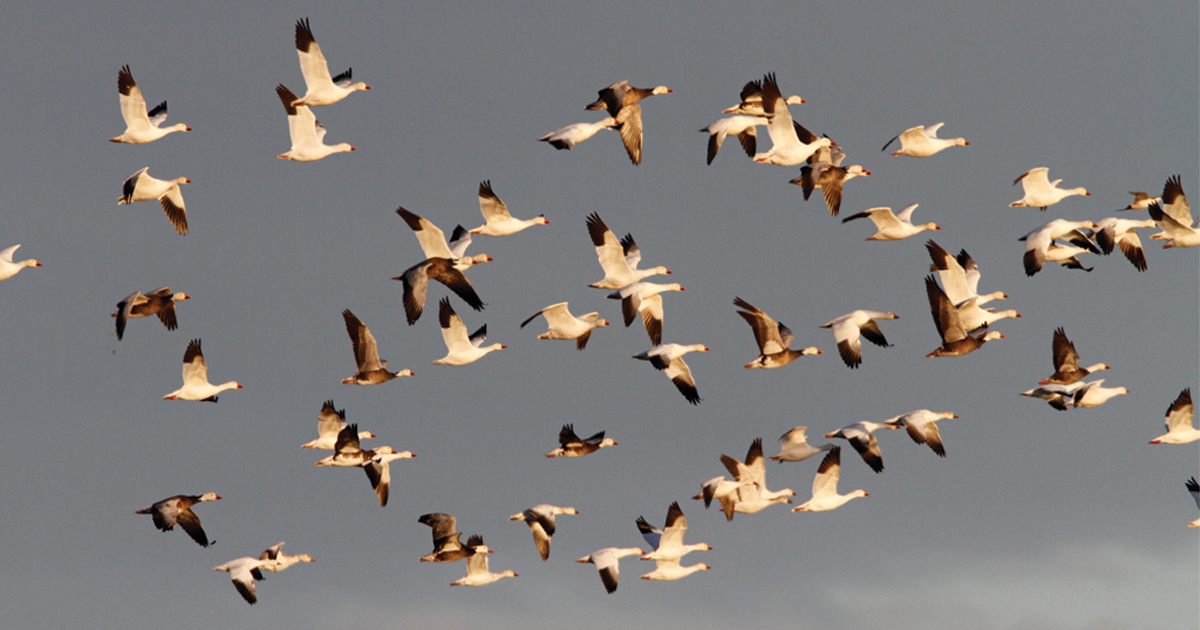Migration Alert: Door Remains Open for Light Goose Migration in Central Flyway
March 1, 2024 – Central Flyway
March 1, 2024 – Central Flyway

A brief return of winter weather last week temporarily put the brakes on the migration of light geese through South Dakota, but with the return of unseasonably warm temperatures and winds out of the south, the door remains wide open for geese to continue their push north toward North Dakota and beyond. Here’s a look at the migration in South Dakota and what hunters can expect in the days ahead.
Leading up to the cold and wind-driven snow that impacted the region last week, big flights of adult snow, blue and Ross’s geese were pouring into the state, reports South Dakota Game, Fish and Parks senior waterfowl biologist Rocco Murano. While the winter weather conditions in northern South Dakota and North Dakota had light geese retreating back south, the snow is now gone and birds are once again on the move within traditional migration corridors.
“At this point, it appears that the James River Valley is again seeing a lot of bird traffic, and there are good numbers of geese further west in the Missouri River corridor as well,” Murano says.
The amount of open water in the state continues to increase, he adds, and with no snow on the ground, geese are having no trouble finding food.
“We have another cold front coming this week that looks to have us returning to somewhat more seasonal temperatures, and that could slow things down again a bit. My concern is that unless we see a storm dump some snow somewhere to the north of us, the geese are going to push hard,” he says. “At this point there isn’t much to stop them from going as far north as they want to go.”
The month of March typically features the peak of the light goose migration through South Dakota, but it is unusual to see large numbers of the birds in North Dakota this early, says Mike Szymanksi with the North Dakota Game and Fish Department.
“We really don’t have much snow. There isn’t snow south of us. There really isn’t much snow north of us, so the migration is probably going to be quite early this year,” Szymanski says, adding that as the amount of daylight increases, the window for migration opens even further for light geese making their way to the Arctic nesting grounds.
Szymanksi says that hunters in North Dakota are likely to find geese in those areas typically used by the birds in the spring, including the James River lowlands and throughout the Highway 281 corridor. One difference that hunters throughout this part of the Central Flyway will notice this year is that with very little snowmelt, there is very little sheet water, and geese are using other waterbodies for roosting and loafing.
“We do encourage hunters to be aware that even though the conditions are drier than other years, there are still going to be wet spots out in fields and muddy conditions on the rural roads as the frost goes out,” Szymanski says. “We ask hunters to use caution and also be respectful.”
With adult birds making up the bulk of the geese in the area, hunters know that there are more opportunities to come in the weeks ahead, but Murano believes that a lot could happen during the current conditions, featuring warm temperatures and big south winds.
“Bird numbers and where they are concentrated, those things are changing so quickly it is hard to stay on top of it all,” Murano says. “We’ll know just how big of a push we’ve had when we get to the backside of this warm weather and the temperatures drop again. If you have plans to hunt here in South Dakota, though, it may be better to get out sooner than later.”
Stay up to date with the latest migration information.